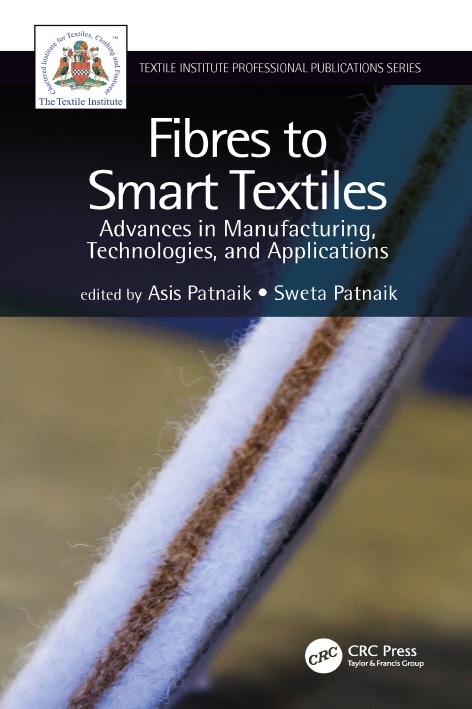Fibres to Smart Textiles: Advances in Manufacturing, Technologies, and Applications
Edited by Asis Patnaik and Sweta Patnaik

Contents
Series Preface……………………………………ix
Preface………………………………………………..xi
Editors………………………………………. xiii
Contributors…………………………..xv
Chapter 1 Textile Fibres and Recent Developments……………………………………….1
Doice Moyo and Asis Patnaik
Chapter 2 Filament Formation and Recent Developments……………………………. 17
Arobindo Chatterjee
Chapter 3 Yarn Formation and Recent Developments………………………………….. 31
Ashvani Goyal
Chapter 4 Fabric Formation and Recent Developments………………………………..63
Rajesh Mishra, Mohanapriya Venkataraman, and Veerakumar
Arumugam
Chapter 5 Knitting and Recent Developments……………………………………………..89
Bibhu Prasad Dash, Rajesh Mishra, and Veerakumar Arumugam
Chapter 6 Non-Woven Fabrics: Technology, Applications and Recent
Developments………………………………………………………………………… 109
Vinay Kumar Midha and Monica Sikka
Chapter 7 Braiding and Recent Developments………………………………………….. 131
Kadir Bilisik
Chapter 8 Preparatory Chemical Processes and Recent Developments………… 153
Naveen V. Padaki, Brojeswari Das, Subhas V. Naik, and
Sanganna A. Hipparagi
Chapter 9 Dyeing and Recent Developments……………………………………………. 169
Prithwiraj Mal and Debojyoti Ganguly
Chapter 10 Printing and Recent Developments…………………………………………… 187
Rasiah Ladchumananandasivam, Iris Oliveira da Silva,
Luciani Paola Rocha Cruz Barros, and Elisângela Bezerra das
Neves Holanda
Chapter 11 Finishing Processes and Recent Developments………………………….. 201
Andrew D. Hewitt and Andrew J. Hebden
Chapter 12 Testing of Fibres, Yarns and Fabrics and Their Recent
Developments………………………………………………………………………… 221
Anindya Ghosh and Prithwiraj Mal
Chapter 13 Recent Developments to Reduce Environmental Impacts of
Textile and Apparel………………………………………………………………… 257
Huantian Cao
Chapter 14 Use of CAD and CAM and Its Recent Developments in Textiles…..269
Ashvani Goyal and Anil Kumar Yadav
Chapter 15 Recent Developments in Textile-Reinforced Composites and
Biocomposites……………………………………………………………………….. 291
Asanda Mtibe, Teboho C. Mokhena, Sudhakar Muniyasamy,
Osei Ofosu, and Mokgaotsa J. Mochane
Chapter 16 Technical Textiles and Recent Developments…………………………….. 315
Asis Patnaik
Chapter 17 Smart Textiles and Recent Developments………………………………….. 331
Sweta Patnaik
Chapter 18 Nanotextiles and Recent Developments…………………………………….. 345
Rajkishore Nayak and Asimananda Khandual
Index……………………………………………………………. 381
Preface
Fibres to Smart Textiles mostly covers all aspects and areas within the textile and clothing manufacturing sectors. The contents in this book have been solely focused from the grassroots level, i.e., from fibres, yarns, and filament levels to its end usage as an environmentally sustainable and acceptable outcome in the form of smart or nanotextiles covering the latest developments and advancements. The book brings together various areas such as fibre, yarn, filament and fabric formations, knitting, non-woven, braiding, dyeing, printing, finishing, textile-reinforced composites and biocomposites, technical textiles, smart textiles, nanotextiles, nanocomposites, etc. Furthermore, testing of fibres, yarns and fabrics, use of computer-aided design (CAD) and computer-aided manufacturing (CAM) in textile products and environment impact of textile processes are also covered in this book. Various authors are chosen, each from their area of expertise, to contribute towards the most recent and updated information related to the chapter. Adopting this approach allows focus on the end user (be it an individual, a team, a service group, etc.) whilst avoiding the probable pitfalls that leads to the creation of the final garment as well as its conception.
The chronological list of chapters that has been followed in the book is superfluous, which enhances the breadth of knowledge and the ease of accessibility by the end user. Starting from the textile fibres gives a brief idea on the types of fibres, their market trends and developments, followed by yarn and filament formations that focus on similar trends and developments. Fabric formation and knowledge on it forms the next chapter that covers various fabrics and various technologies used in making the same. Knitting, non-woven fabrics and braiding and their trends and developments follow up as the next two chapters that are sequentially arranged. Chemical processing of textiles including its preparatory process comes as the next chapters, where the various kinds of traditional and recent modes and methods of treating the fibres and fabrics have been discussed. Any final end product in the form of a garment is incomplete without treating them with colours, prints and desired finishes; this is where the chapters on dyeing, printing and finishing, respectively, come into picture.
Be it fibres or yarns or fabrics, it is vital that they are tested to identify and understand their trends and behaviour that brings us the chapter on testing. Testing also gives us an idea and a platform on understanding and accessing the fibre or fabric on its impact to the environment pre- and post-usage of the product. The chapter on environmental impacts covers more or less the same, and recent developments that have taken place. After going through all the earlier chapters, the only next thing that comes to mind is the design aspect which the chapter on CAD and CAM try to address. The last few chapters towards the end, which are textile composites and biocomposites, technical textiles, smart textiles and nanotextiles and nanocomposites, are huge areas of discussion in themselves, seeing that they are very much in trend and the need of the hour environmentally on a global level, yet the authors have tried to bring in relevant, recent and updated information in a concise manner.
This book reflects and represents the contribution and effort of many people across the globe, without whom it could not have been showcased the way it is, so a big thank you to everyone is in order. We both hope that you find this book relevant, recent and interesting in whichever area you are working in to, thereby enhancing your knowledge base. We are thankful to various sources for granting permission to use figures and tables used in this edited book.
